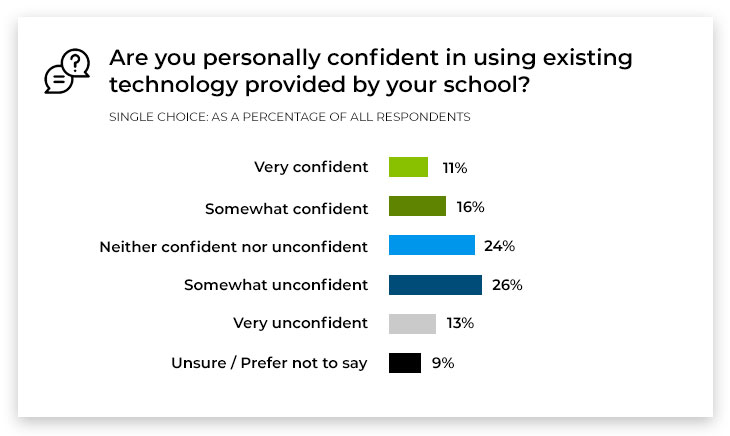Let’s be honest. The experience of delivering remote education during the pandemic has not been an easy one for teachers or school leaders, with many feeling they had to adapt to new ways of working overnight and with schools trying to deliver as much of the curriculum as possible both remotely and in classrooms to the vulnerable children and children of critical workers when they couldn’t be at home.
Some, like the Forest Federation in Northamptonshire and Biggin Hill Primary School in Bromley, London, were in a more fortunate position, however, having already embarked on a full-scale approach to modernising their ICT systems, but regardless, the pivoting of schools across the UK to remote digital learning was a huge achievement for which teachers and school leaders must be applauded. The important question now remains – where do we go from here with technology-enabled learning?
Technology Can Improve Education
While education technology (EdTech) has great potential to support, enhance and improve teaching, learning and assessment, adoption and innovation has been hampered by a number of challenges from funding (only 27% of teachers in both Primary Schools and Secondary Schools agreed in a recent BESA survey of English maintained schools that their school was well equipped with ICT infrastructure and devices ) to teacher confidence (a study commissioned by RM before the pandemic showed that only 27% of teachers surveyed felt confident using existing technology provided by their school). With the wide variation in reliable internet connectivity and technical expertise across school communities, as well as a relatively small body of evidence of what works and what represents the best value for money, it’s no surprise that many schools are dubious of relying more on EdTech solutions.

Source: Research carried out by C3 Education on behalf of RM, 2019
While the lockdown seeds of EdTech may not always have been sewn on entirely fertile ground however, they have borne fruit. Aside from the fact that EdTech made it possible for a level of sustained education to continue, we have seen other benefits arise from this crisis. While technology may never provide a like-for-like substitution for in-person teaching, we now have an opportunity to keep the elements of remote teaching and learning that worked well and integrate them into ongoing teaching practices and curriculum delivery.
The Benefits of EdTech during Lockdown
For starters, many students actually enjoyed learning online, using devices, working in virtual classrooms while collaborating with friends. These students are digital natives after all, comfortable with working on-screen (or, indeed, ‘multi-screening’), navigating games, websites and apps, consuming multi-media in the same way Gen X had to rely on books. We’ve all heard the prediction that ‘65% of children entering primary school today will end up working in jobs that don’t yet exist’ and while ‘twenty-first century skills’ are about far more than just digital literacy, we can be pretty certain that technology will continue to play a large part in the jobs of the future.
Remote learning gave students the opportunity to get familiar with using tech for work, communicating and collaborating over Microsoft Teams, Google Meet or Zoom – skills they’ll likely need in the future. As we move back into the classroom, is it time to think about how teaching and learning can be augmented by students having their own devices in class?
The ability of EdTech to make learning more personalised – whether through adaptive technology or simply by allowing students to work at their own pace – is another benefit that has shone through during lockdown. In a recent article in The Guardian, Laura McInerney, journalist and schools expert, even went as far as to say: “By accident, we may have hit upon a solution to one of the achievement gap’s biggest causes: children need different amounts of learning time […] “One way to tackle the achievement gap is surely in-school lessons followed by more personalised online learning, either at home or in after-school clubs.”
And we know EdTech can be fantastic for levelling the playing field for children with special educational needs or disabilities. Automatic text-readers, dictation software, spell-check and other review tools can help with educational needs such as dyslexia, for example.
“Technology enables us to push our gifted children at the same time as look after those pupils who need more support such as those with visual impairments – it really does level up the playing field”.
Dan Lister, Chair of Governors, Forest Federation, Northamptonshire

All that without having even mentioned the potential for EdTech to reduce teacher workload, revolutionise formative and summative assessment, add extra stimulation and engagement in class, and to facilitate communication and collaboration both within and beyond the school.
Building on Progress of School ICT Investment
Of course, it’s not as though before lockdown no-one had bothered to consider EdTech. Many schools and trusts were already making big strides in this area – buying-in digital resources and platforms to help with teaching and homework, bringing in as much new hardware as budgets and priorities allowed, and starting to look at a longer-term digital strategy in line with their vision for school improvement. One EdTech report shows a four-fold increase in the use of EdTech in the classroom over the past decade, with 79% saying they use it in every class. Covid only pushed forward a movement that had already begun – and while the speed of change may not have been entirely comfortable, thanks to the intense efforts of teachers it worked out rather well. Imagine what could be achieved now with time, backing from Government, and a national (international, even) conversation about what really works?
The Government launched their comprehensive vision for technology in schools back in 2019, Realising the potential of technology in education, alongside a flurry of initiatives to take it forward, such as the launch of the EdTech Demonstrator programme, intended to boost peer-to-peer support on the effective use of technology, and the creation of an EdTech Leadership Group bringing together educators and industry to plot a way forward. At the same time, £10 million in funding was announced to support the use of EdTech in schools and a further £4.6 million innovation fund. While the advent of Covid-19 may have overshadowed the work of these initiatives, they have been bubbling quietly away in the background, and as we (hopefully) begin the slow journey back to normality we should start to see more output from them, with more direction and greater support to make change happen.
“Put simply, all of my staff now have access to IT that works reliably and quickly!”
James Ellis, Headteacher, Biggin Hill Primary School, London

So how ready is your school for the EdTech era? If you’re in the relatively early stages of the journey, it might feel like too much to tackle all at once. You might be worrying about your resource budget, the degree of internal expertise you have, the age and quality of your hardware and storage, the quality and speed of your internet access, the number of licenses and subscriptions you already have, managing change with staff, governors and families, to name a few.
A small group of primary schools in Northamptonshire shared some of these challenges before working with RM to become one of the most technically advanced groups of Primary Schools in the country. Read our Forest Federation Case Study to find out how they have embraced technology as an enabler to support their long-term vision to modernise their schools.
Want to know more? Get in touch to find out how RM could help your school continue to build on the progress you’ve made technologically over the past 12 months.
